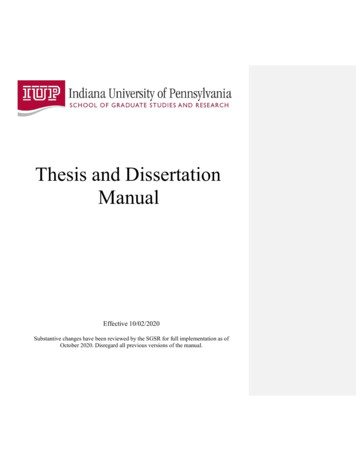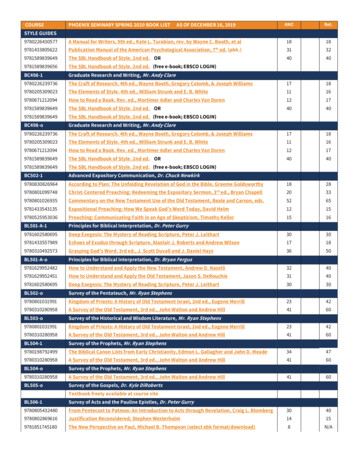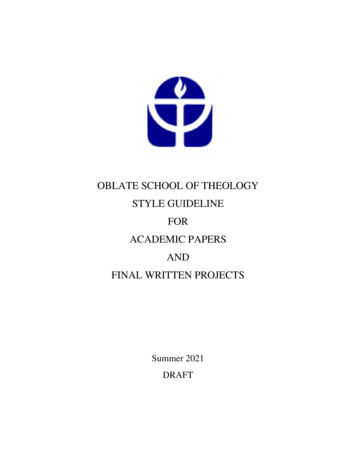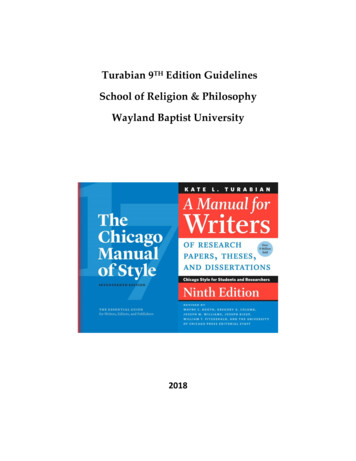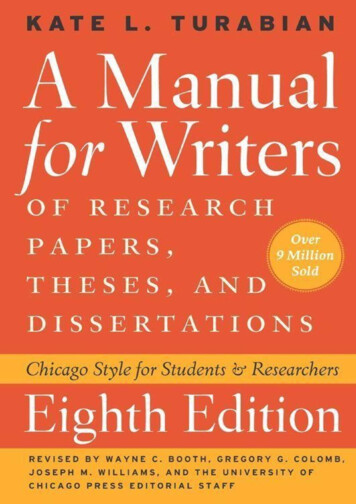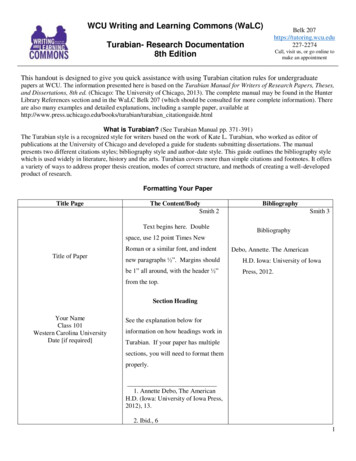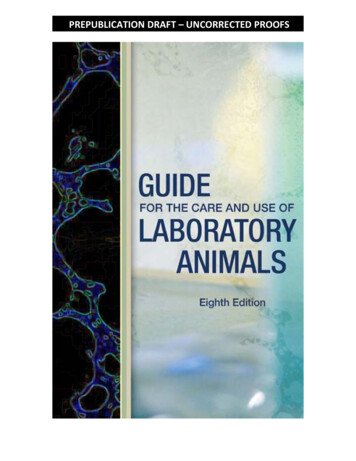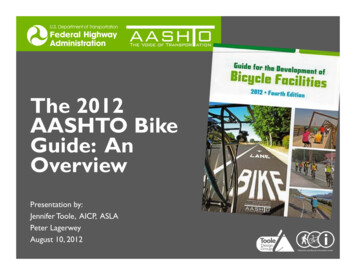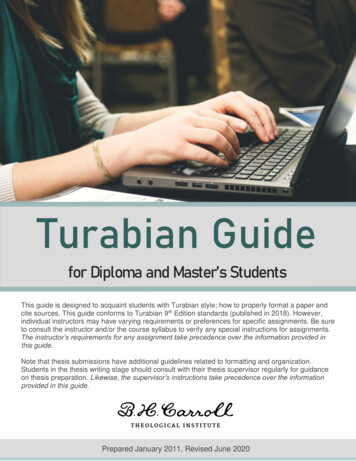
Transcription
Turabian Guidefor Diploma and Master’s StudentsThis guide is designed to acquaint students with Turabian style; how to properly format a paper andcite sources. This guide conforms to Turabian 9th Edition standards (published in 2018). However,individual instructors may have varying requirements or preferences for specific assignments. Be sureto consult the instructor and/or the course syllabus to verify any special instructions for assignments.The instructor’s requirements for any assignment take precedence over the information provided inthis guide.Note that thesis submissions have additional guidelines related to formatting and organization.Students in the thesis writing stage should consult with their thesis supervisor regularly for guidanceon thesis preparation. Likewise, the supervisor’s instructions take precedence over the informationprovided in this guide.Prepared January 2011, Revised June 2020
TABLE OF CONTENTSGENERAL NOTE ABOUT THE CARROLL TURABIAN GUIDE . 6A Note About Citation Management Tools . 6Formatting Changes in the 9th edition of A Manual for Writers . 7Page Set Up and General Formatting Notes . 7FRONT MATTER . 8Title Page . 8Table of Contents . 9BODY OF THE PAPER . 9Headings and Subheadings . 9Quotations: Run-in and Block . 10URLs (Uniform Resource Locators): Format and Line Breaks . 10Line Breaks for Long URLs . 10CITING SOURCES: THE BASICS . 11FORM 1: NOTES/BIBLIOGRAPHY FORM . 12Basic Patterns in Notes-Bibliography Form. 14The Bible and Other Sacred Works (see Section 17.8.2, p. 203) . 14Book with One Author (see Section 17.1.1, p. 171) . 14Book with Multiple Authors (see Section 17.1.1, p. 171) . 14Book with Two Editors, No Author Listed (see Section 17.1.2, p. 172) . 14Journal Article (see Section 17.2, p. 187) . 14Journal Article from an Online Database (see Section 17.2, p. 187) . 15Online/Electronic Book (see Section 17.1.10, p. 186) . 15i
Kindle and Other Personal E-book Services (see Section 17.1.10, p. 186) . 16Web Site (see Section 17.5, p. 194) . 16Bibliography Style Sample Paper . 18FORM 2: REFERENCE LIST STYLE (WITH PARENTHETICAL CITATIONS) . 23Basic Patterns for Reference List Style . 24The Bible and Other Sacred Works (see Section 19.8.2, p. 271) . 24Book with One Author (see Section 19.1.1, p. 238) . 24Book with Multiple Authors (see Section 19.1.1, p. 238) . 24Book with Two Editors, No Author Listed (see Section 19.1.2, p. 239) . 24Journal Article in Print (see Section 19.2, p. 254) . 24Journal Article from an Online Database (see Section 19.2, p. 254) . 24Online/Electronic Book (see Section 19.1.10, p. 253) . 25Kindle and Other Personal E-book Services (see Section 19.1.10, p. 253) . 26Web Site (see Section 19.5, p. 261) . 26Reference List Style Sample Paper . 27BACK MATTER . 32ADDITIONAL RESOURCES . 32ii
GENERAL NOTE ABOUT THE CARROLL TURABIAN GUIDEThis guide is intended to orient new students to Turabian citation style.Turabian is the preferred citation style for many theologicalpublications, as well as the required format for Caroll dissertations andtheses.Students are expected to purchase a copy of the officialTurabian manual:Turabian, Kate. A Manual for Writers of Research Papers, Theses,and Dissertations. 9th ed. Edited by Wayne C. Booth, Gregory G.Colomb, Joseph M. Williams, Joseph Bizup, and William T.FitzGerald. Chicago, University of Chicago Press, 2018.A Manual for Writers, 9th ed. along with any supplemental instructions your instructormight provide, is the comprehensive authority on all Turabian matters. The officialTurabian manual will be refenced by section name (Ex. See Section 17.1.1.1, p.171) orsimply A Manual for Writers (Ex. See p. X of A Manual for Writers for more guidance).This guide will occasionally reference its own internal components (Ex. See Appendix Aof ‘this document’ or ‘this guide’) with hyperlinks for easy navigation.This guide is not intended to advise students on matters of composition or grammar. Forguidance with academic writing, please see the Additional Resources section.A Note About Citation Management ToolsIn recent years, citation management tools like Zotero and EasyBib have emerged,along with built-in citation generators in academic databases like EBSCO, toautomatically format sources and keep a running bibliography (see Figure 1 for anexample of an automatically-generated citation from EBSCO). Section 15.6 (p. 147) of AGuide for Writers advises researchers to use these tools cautiously, since theresearcher is ultimately responsible for correctly formatting citations.Figure 1: Citation generator in EBSCO databasesCitation management tools work best with conventional types of sources (ex. a bookwith one author, an article retrieved from an academic database), but less for emerging
formats (ex. a ‘tweet’ on Twitter, a blog post). Researchers should verify auto-formattedcitations with citation standards in A Manual for Writers.Formatting Changes in the 9th edition of A Manual for WritersThe last edition of Carroll’s Turabian manual was based on the 7th edition of A Manualfor Writers, published in 2007. The latest edition, published in 2018, has several minorformatting changes. The changes reflect the need for guidance with citing emergingformats of information (i.e. ebooks, Twitter posts).The major changes in the 9th edition include: Journal articles used headline capitalization and are enclosed in quotation marks.Digital object identifiers (DOI) should begin with https://Access dates for digital resources are now written before the date of publication(ex. Access January 1, 2020. http://www.example.com)When citing websites, you must include either the publication date/last modifieddate OR the date you accessed (preference is given for publication date)The use of Ibid. to cite a source used consecutively in a paper is discouraged.Use a shortened note instead.Do not italicize digital resources that lack a print counterpart (ex. Wikipedia). Ifyou cite an online resource that is also available in print, italicize it (ex. New YorkTimes).More information on changes in the 9th edition of Turabian can be found here andchanges in the 17th edition of Chicago can be found here.Page Set Up and General Formatting NotesMargins should be at least 1’’ on all sides of the page. See Section A.1.1 (p. 384).The font chosen should be readable. Times New Roman, 12-point type is preferred, orArial 10-point font may be used. Use the same font type consistently throughout thepaper. The font size may be different for footnotes or endnotes (10-point type,preferred) than for the body of the paper. Use one space, rather than two, betweensentences.In general, spacing of all lines in a paper should be double-spaced, except the following,which should be single-spaced: Block quotations (Section 25.2.2, p. 361)Table titles and figure captionsLists in appendixes
Additionally, the following items should be single-spaced with a blank line between eachitem: Some front matter elements, such as the table of contents and lists of figures ortablesFootnotes or endnotesBibliography or reference list entriesUse only one space (not two) between the end of one sentence and the start of a newone Section A.1.3 (p. 385).Page numbers usually appear in one of four places: 1) centered on the footer, 2) rightaligned on the footer, 3) centered in the header, or 4) right-aligned in the header (seeSection A.1.4.1, p. 385). Choose one of these options and be consistent throughoutthe paper.The page number should not appear on the title page (see Section A.1.4, p. 385)FRONT MATTERSee Section A.2.1 (p. 388) of A Manual for Writers for specific information related tofront matter.Title PageThe first page of your document is the Title Page. Note that the title page does notinclude a page number.For the Title Page for a Carroll course paper, keep in mind the following: Set the top margin to 2 inchesUse headline-style capitalization (capitalize each word) through the page andcenter-align all the words on the title pageThe title of the paper itself should be in bold. If your paper has a subtitle, add acolon after the title and put a space between title and the subtitle.Put 4 blank lines (double-spaced hard carriage returns) between the schoolname and the paper’s titlePut 4 blank lines (double-spaced hard carriage returns) between the paper’s titleand the “A paper submitted to.” statementPut one blank line (double-spaced hard carriage return) between the courseinformation and the “by” statementOmit page numbers on title pageThis guide contains a sample title page, as does Section A.2.1.7 (pp. 391-92) of AManual for Writers.
Table of ContentsPapers divided into chapters require a table of contents and sometimes, instructors willrequire a Table of Contents listing paper section headings—and possibly subheadings.In the event your instructor requires a paper divided into chapters, or wants headingsand subheadings rendered in a Table of Contents, please refer to this section of theGuide. Formatting for a Table of Contents is discussed at on Appendix A.2.1.7 (p. 391).Any time a Table of Contents is used in a Carroll paper, Roman numerals should beused to number that page. Head the page with the word Contents (initial caps, centered, bold).Insert two blank lines following the word Contents.Begin the Table of Contents with a listing of the parts, and the pages, that follow,in order: chapters, headings and subheadings (first and second level headingsonly) as they appear in the body (text) of the paper, and bibliography. Formateach part flush left.In numbering Table of Contents parts or items listed, reference the page onwhich the item begins, not the full range of pages for the item. Format the pagenumber on which each item starts flush right. Use Roman numerals (i, ii, iii)rather than Arabic numbers.BODY OF THE PAPERDetailed information on formatting the body of the paper can be found in Section A.2.2(p. 400).Headings and SubheadingsFormatting for up to five levels of headings and subheadings are detailed on AppendixA.2.2 (pp. 397-99). A Manual for Writers cautions against use of more than threesubheading levels.Consider limiting your uses of headings to the first two levels:First Level: Center-Aligned, Boldfaced, and Headline-Styled Capitalization.Second Level: Center-Aligned, Regular Typeface, and Headline-Styled CapitalizationIn the uncommon event your instructor requires a paper divided into headings andsubheadings, please refer to this section of the Guide.(This guide contains examples of first-level and second-level headings).
Quotations: Run-in and BlockAny time you use a source, either by directly quoting the source or by paraphrasing anidea, you must cite that source. For further details on citation, see the section “CitingSources” below. In this section, formatting of quotations in the text (body) of the paper isdiscussed.The Turabian Manual discusses two kinds of quotation at Section 7.5 (pp. 74-75),Section 25.2.1-2 (pp. 348-352), and Figure A.9 (p. 392).The Manual distinguishes between shorter "run-in quotations" of four lines or less fromlonger "block quotations" of more than five lines. Run-In Quotations: format like text in the body of the paper.Block Quotations: should be single-spaced, with left side of the block indentedlike the first line of a paragraph.The supplemental pages at the back of this guide contain sample text pagesdemonstrating use of both run-in and block quotations.URLs (Uniform Resource Locators): Format and Line BreaksYou will likely have to cite URLS for web-based sources in your footnotes andbibliography and possibly in the body of your paper. A Manual for Writers discussesgeneral formatting for URLS in Section 15.4.1.3 (p. 144) and line breaks for URLs inSection 20.4.2 (p. 304). Whenever possible, include a permalink or digital objectidentifier (DOI) in your citation instead of copying and pasting the URL in the addressbar within a database. URLs can change quickly, leaving your reader unable to accessyour sources.If your source does not have a permalink or DOI, simply copy the URL exactly as itappears in the address bar of your web browser and paste it in your document.0215 Donot add punctuation marks (i.e. a period at the end), capitalize letters (URL addressesare case-sensitive), or enclose the URL in brackets or parentheses (this will break thelink). It is not advised to break the URL, but some URLS are too long to fit on a singleline. Here are some guidelines for adding line breaks to URLs.Line Breaks for Long URLsWhile Microsoft Word and other word processors automatically inserts page breaks forURLS longer that one line, A Manual for Writers has specific instructions on where tocreate breaks in long URLs. If a URL does not fit on a single line, the break should bemade: before a single slash (/), a period, a hyphen (-), or any other punctuationmark,before or after an equal sign ( ) or an ampersand (&), or
after a colon (:) or double slash (//).A hyphen should never be added to a URL to denote a line break. Simply copy the URLfrom your web browser and paste it in your document. Insert a space with the spacebar(NOT the Enter key) where needed.This guide also contains examples of how to sources with URLs in both the notesbibliography style and reference list style. Additionally Section 20.4.2 (p. 304) of AManual for Writers has several examples of URLS with appropriate line breaks.CITING SOURCES: THE BASICSAny time you use a source, either by directly quoting the source or by paraphrasing anidea, you must cite that source. Chapter 15 of A Manual for Writers discusses generalcitation practices.When citing sources using Turabian style, two options are available:1. Footnotes/endnotes accompanied by a bibliography (referred to as“bibliography style” or “notes-bibliography style”) Bibliography style is the citationoption utilized in most Carroll courses and programs. Chapters 16 & 17 of AManual for Writers discusses this form.Examples of the bibliography style in guide will be indicated with:N for footnotes or endnotesB for bibliographic entries2. Parenthetical references accompanied by a reference list (referred to as“reference list style” or “author-date style”). Reference list style is typically used inthe social sciences (psychology and sociology) and physical sciences. Chapters18 & 19 of A Manual for Writers discusses this form.Examples of the reference list style in guide will be indicated with:P for parenthetical citationsR for reference list entriesBoth forms are outlined in this guide, while comprehensive guidelines can be found in AManual for Writers. Examples of citations in this guide will be given in blue font, thoughstudents should use their default font color (black) of their word processor. Yourinstructor will advise you on the appropriate form, along with any other formattinginstructions.
FORM 1: NOTES/BIBLIOGRAPHY FORMWhen bibliography style is used, a superscript number at the end of the sentence wherethe quotation or paraphrase is used lets the reader know that you have referenced asource. Here is an example:He wrote: “The perfect surrender and humiliation was undergone by Christ:perfect because He was God, surrender and humiliation because He was man.”1Indicate the citation with a no. in superscriptThe superscript number should correspond with the note giving information on thesource being cited. This may be done on the page where the citation occurs (called afootnote) OR in a notes listing compiled at the end of the paper (called an endnote).Consult with your instructor on their preference for either footnotes or endnotes.The pattern for all footnotes or endnotes is as follows:NoteNumberIndent 1Space51.Author Name(First Name, Surname)Title of SourcePublication Place, Publisher, Year of Pub.1. C. S. Lewis, The Case for Christianity (New York: Simon & Schuster, 1996),Page no.The bibliography should be listed at the end of the paper, beginning on a new page.Bibliographic entries are like notes, but they have a slightly different form. Bibliographicentries follow this general pattern:Author Name(Surname, First Name)Title of SourcePublication Place, Publisher, Year of Pub.Lewis, C. S. The Case for Christianity. New York: Simon & Schuster, 1996.Use Hanging Indent for bibliographic citations (Second & subsequent lines are indented ½ in on the left margin)Chapter 16 of A Manual for Writers includes numerous examples of formatting footnotesor endnotes (p. 149). In general, you should: Indent the first line of each note as you would a paragraphBegin each note with its reference number, printed as regular text with a periodand space between the number and the text of the note. Superscript (the defaultin Microsoft Word) may be used for the numbers, though regular text is preferred.To convert the note numbers from superscript to regular text, do the following foreach note:o After you have inserted the note, select it with your cursor.o Go to the “Font” menu and uncheck the box labeled “Superscript.” Whilehere, make sure the text size and font are correct (i.e. Times New Roman,size 12). Make the font and font size the same as the text of your paper.o Hit “OK.”
Keep in mind that the note numbers used in the body of your paper should always beformatted as superscript (ex. 1 ). Regular text size should only be used for footnote orendnote numbers appearing in the notes section(s) on the page of citation (footnotes) orthe end of the document (endnotes).Use shortened notes subsequently to the first full citation as needed. This may be usedto shorten a note when the full bibliographic information for the same work has alreadybeen presented earlier in the paper. Example:25. C. S. Lewis, The Case for Christianity (New York: Simon & Schuster,1996), 51.26. David G. Myers, “On Professing Psychological Science and Christian Faith,”Journal of Psychology and Christianity 15, no. 2 (Summer 1996): 146.27. Lewis, Case, 56.Example of shortened citation
Basic Patterns in Notes-Bibliography FormChapter 16 of A Manual for Writers covers the notes-bibliography form in depth.The Bible and Other Sacred Works (see Section 17.8.2, p. 203)Cite these types of sources in footnotes or endnotes. They do not need to be included inthe bibliography. When citing the Bible, include the name of the book, abbreviated. Also,include the chapter number and verse number, but not a page number. Identify theversion of the Bible you are using in the first citation. (See pp. 351-54 for the lists ofabbreviations for books of the Bible and versions of the Bible.)Use the pattern below when citing the Bible or other sacred works.N1. 2 Cor. 4:16-18 (RSV)Book with One Author (see Section 17.1.1, p. 171)N1. C. S. Lewis, The Case for Christianity (New York: Simon & Schuster,1996), 51.BLewis, C. S. The Case for Christianity. New York: Simon & Schuster, 1996.Book with Multiple Authors (see Section 17.1.1, p. 171)N1. Henry T. Blackaby and Claude V. King, Experiencing God: Knowing andDoing the Will of God (Nashville: Broadman & Holman, 2004), 80.BBlackaby, Henry T., and Claude V. King. Experiencing God: Knowing and Doingthe Will of God. Nashville: Broadman & Holman, 2004.Book with Two Editors, No Author Listed (see Section 17.1.2, p. 172)N1. Charles F. Pfeiffer and Everett F. Harrison, ed., The Wycliffe BibleCommentary (Chicago: Moody Press, 1990), 451.BPfeiffer, Charles F., and Everett F. Harrison, eds. The Wycliffe BibleCommentary. Chicago: Moody Press, 1990.Journal Article (see Section 17.2, p. 187)N1. David G. Myers, “On Professing Psychological Science and ChristianFaith,” Journal of Psychology and Christianity 15, no. 2 (Summer 1996): 146.BMyers, David G. “On Professing Psychological Science and Christian Faith.”Journal of Psychology and Christianity 15, no. 2 (Summer 1996): 143-9.
Journal Article from an Online Database (see Section 17.2, p. 187)N1. Thomas H. Tobin, “What Shall We Say that Abraham Found? TheControversy behind Romans 4,” Harvard Theological Review 88 (October1995): 439, http://firstsearch.oclc .org/WebZ/FTFETCH?sessionid fsapp855452-gbtqbu5zjztls6:entitypagenum 12:0:rule 100:fetchtype fulltext:dbname WilsonSelectPlus FT:recno 1:resultset 3:ftformat HTML:format BI:isbillable TRUE:numrecs 1:isdirectarticle FALSE:entityemailfullrecno 1:entityemailfullresultset 3:entityemailftfrom WilsonSelectPlus FT:.BTobin, Thomas H. “What Shall We Say that Abraham Found? The Controversybehind Romans 4.” Harvard Theological Review 88 (October 1995): 437452. http://firstsearch.oclc.org/WebZ/FTFETCH?sessionid Fsapp8-55452-gbtqbu5zjztls6:entitypagenum 12:0:rule 100:fetchtype fulltext:dbname WilsonSelectPlus FT:recno 1:resultset 3:ftformat HTML:format BI:isbillable TRUE:numrecs 1:isdirectarticle FALSE:entityemailfullrecno 1:entityemailfullresultset 3:entityemailftfrom WilsonSelectPlus FT:.Some online sources provide a permanent identifier such as a digital object identifier(DOI). In such cases, the DOI may be used instead of the website address (see, section15.4.1.3, p. 145). An example is provided below.N1. Jerome H. Neyrey, “God, Benefactor and Patron: The Major CulturalModel for Interpreting the Deity in Greco-Roman Antiquity,” Journal for theStudy of the New Testament 27, no. 4 (June 2005): 488, https://doi:10.1177/0142064X05055749.BNeyrey, Jerome H. “God, Benefactor and Patron: The Major Cultural Model forInterpreting the Deity in Greco-Roman Antiquity.” Journal for the Study ofthe New Testament 27, no. 4 (June 2005): e/Electronic Book (see Section 17.1.10, p. 186)In general, electronic book citations found on the web should list the complete webaddress where the source may be found (as in the example below).NB1. Walter Rauschenbusch, A Theology for the Social Gospel (New York:Macmillan, 1919), 77, http://books.google.com/books?id Jaw8AAAAYAAJ&printsec frontcover&dq Gospel&hl en&ei mU1QTerfEYL8Aa3493IDg&sa X&oi book result&ct result&resnum 10&ved 0CGgQ6AEwCQ#v onepage&q&f false.Rauschenbusch, Walter. A Theology for the Social Gospel. New York: Macmillan,1919. http://books.google.com/books?id Jaw8AAAAYAAJ
&printsec frontcover&dq Gospel &hl en&ei mU1QTerfEYL8Aa3493IDg&sa X&oi book result&ct result&resnum 10&ved 0CGgQ6AEwCQ#v onepage&q&f false.When an electronic version of a book is downloaded from a commercial database, suchas ProQuest, the URL is not needed. The following citation pattern may be used:N1. Thomas Jackson and Robert Sanderson, Two Treatises on the Church(London: Elliot Stock, 1901), 3, Logos.BJackson, Thomas, and Robert Sanderson. Two Treatises on the Church.London: Elliot Stock, 1901. Logos.Kindle and Other Personal E-book Services (see Section 17.1.10, p. 186)E-books access from personal subscription services have app-specific page numbers.The pagination changes depending on the device use to read the book (i.e. a laptop vs.a tablet). Omit the page number and use fixed markers, like sections or chapters, tohelp readers who might be accessing the ebook on a different type of device.N1. Malcolm Gladwell, Outliers: The Story of Success (Boston: Little,Brown, 2008), chap. 1, sec. 4, Kindle.BGladwell, Malcolm. Outliers: The Story of Success. Boston: Little, Brown, 2008.Kindle.Some online sources provide a permanent identifier such as a digital object identifier(DOI). In such cases, the DOI may be used instead of the website address (see p. 138,section 15.4.1, and p. 243, section 19.1.8). An example of an electronic version of anedited book with a DOI is provided below.NB1. Thomas Christensen, ed., The Cambridge History of Western MusicTheory (Cambridge, UK: Cambridge University Press, 2002), 29, https://doi:10.1017/CHOL9780521623711.Christensen, Thomas, ed. The Cambridge History of Western Music Theory.Vol. 1. Cambridge, UK: Cambridge University Press, 2002. htttps://doi:10.1017/CHOL9780521623711.Web Site (see Section 17.5, p. 194)Web pages often lack a fixed publication date. When available, share the latest date ofpublication (ex. ‘Last modified July 1, 2016’). If there is no date listed, document thedate you accessed the page.N1. Paul Lusher. “Psalms, Hymns and Spiritual Songs: Music to Shape theSoul,” Center for Church Music, accessed June 1, 2020,
oul.BLusher, Paul. “Psalms, Hymns and Spiritual Songs: Music to Shape the Soul.”Center for Church Music, accessed June 1, the-soul.
B. H. CARROLL THEOLOGICAL INSTITUTEBibliography Style Sample PaperTITLE OF PAPER: 1ST LINE LONGER2ND LINE OF TITLEA PAPER SUBMITTED TODR. JOE INSTRUCTORIN PARTIAL FULFILLMENT OF THEREQUIREMENTS FOR THE COURSEBHCTI 5000 GATEWAYBYSTUDENT NAMEJANUARY 20, 2020
ContentsIntroduction .1Anxiety .2Guilt . 10Penance . 18Restitution . 26Bibliography . 34ii
Introduction"Sancte Socrates, ora pro nobis.”1 Erasmus dictio erat, tempus ReformationisHumanist catholicam nota. Quote eius a documentis antiquis philosophus illeaestimatus est; si consideretur tantum ut ubique Graecas literas ad indicium vigebatRenaissance tempus absolute ut ideam sine comment. Sed forte subsit veteresSocrates postea sententias diximus; et mirum esse philosophorum sententias velabysmally humiliabit eos. In brevi charta data ego arguere ex duabus Socratissignificant perceptiones stratum Fathers- Justini martyris ecclesiam Tertullian.Ut bene cum vehitur disputatione breviter Philosophi; deinde huiusmodi exemplapossumus mane sacrificium Christianorum positivus sive negativus Appraisals Socratis(ex quo et ceteris illis); deinde finis, aditus innuit amplius quaerendum.2.500 annorum spatio tamen cognoscitur Socrates "egregiam multis modis, quodfigura provocet fovet et excitat."2 Born in CDLXX forte in B.C. LXX annorum et mortuusest in CCCXCIX B.C. Socrates Vita mutatur in verbo eius mane 40s authoritatem(Delphicum oraculum), nemo sapientior quam Socrates testatur. In hoc sensu facereconari, focum Socratis ratio facta inquisitione; quaestione alii solutiones quaerere etrespondendi ratione sibi multos amicos. Religiosi in patria Athenas obiceretur speperdidit illum; Socrates autem perseverantes dimiserunt adinventiones usu et receptasententia est hoc quod videbat sanabatur, sed ex divino mandato compromissum.1. Desiderius Erasmus, Colloquies of Erasmus, vol. 1, ed. E. Johnson, trans. N. Bailey,(Lo
Turabian manual: Turabian, Kate. A Manual for Writers of Research Papers, Theses, and Dissertations. 9th ed. Edited by Wayne C. Booth, Gregory G. Colomb, Joseph M. Williams, Joseph Bizup, and William T. FitzGerald. Chicago, University of Chicago Press, 2018. A Manual for Writers, 9th ed.
